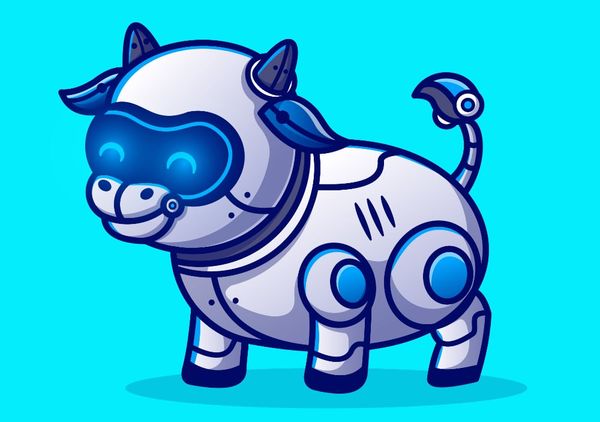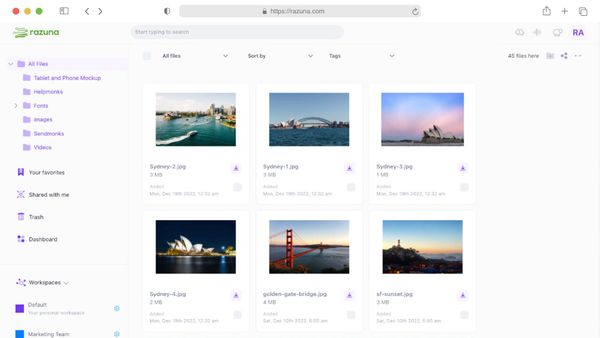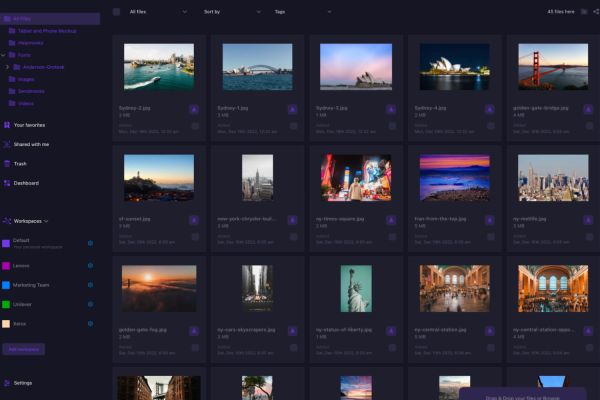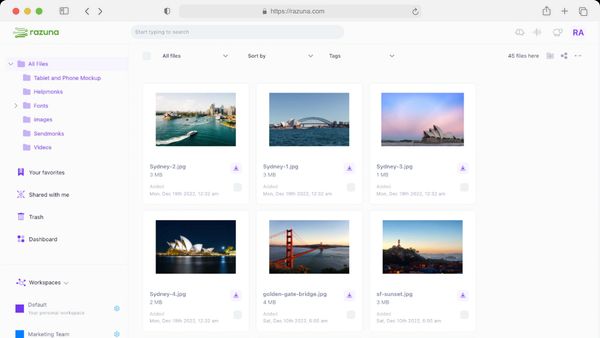
Announcing Collect+: Save and share everything
COLLECT+ is a productivity tool that helps you save and share everything you find on the web. It is built into the Razuna digital asset management platform.
Read nowOrganizations in every industry worldwide are looking for ways AI can help their businesses. Artificial Intelligence (AI) is changing how people work across all industries, and it will likely do the same for your business.
But what is the true role of artificial intelligence in digital asset management systems? And do we need this union of conventional productivity tools and artificially intelligent innovation?
This article examines the use of artificial intelligence in digital asset management systems and why it matters. This technological combo is a winner if you want to make the most of your digital assets, manage them more effectively, and take efficiency to new heights. Read on to discover why.
A digital asset management system is a software solution that allows you to manage your digital assets.
It can be used to oversee almost everything you do with those digital assets, from the time they are created to their ultimate destination. It offers a centralized repository to organize and store all digital assets, from text documents to images, videos, audio files, and more.
DAM systems offer various features that allow you to collaborate on digital content, share files, and distribute them to other platforms.
DAM systems offer countless benefits. Your business type will dictate which DAM features will benefit you the most. But these are the top four benefits that almost all businesses appreciate about their DAM systems.
Investing in DAM is one of the top strategies for greater efficiency because the more organized your digital assets are, the easier it is to retrieve them when needed. This is crucial when you need to locate files with critical information quickly.
Leverage artificial intelligence in digital asset management systems, and your file organization and retrieval will get a serious boost. With a few clicks, you'll easily find anything in your digital asset portfolio, and everything from individual tasks to team projects is simpler.
DAM systems enable team members to access and share files easily. DAM systems ensure everyone works on the most up-to-date assets thanks to version control. Users can collaborate and leave comments on files directly from the platform. The review and approval process is streamlined when your team uses a DAM system. This all results in a smooth and efficient collaborative workflow.
Some of the best benefits of DAM are in brand development and brand marketing. Your branding teams can access brand guidelines and share and collaborate on images, graphics, and other creative content. But original versions are always safe and secure, maintaining brand consistency.
DAM systems allow administrators to set access permissions for users to view, edit, or share specific files. This preserves the integrity of your files and protects them from unauthorized access.
Because of the above benefits, DAM also saves your organization time and money. Its versatility as a management tool across all departments maximizes your human resources, so even small teams get more done. It's more than just a repository for digital assets; it's the ultimate productivity tool.
Since it first burst into the mainstream, artificial intelligence has slowly but steadily made its way into more and more areas of the business environment. We'd be hard-pressed to find an industry that doesn't leverage artificial intelligence in one way or another.
Originally, AI in DAM was mostly used for automating repetitive tasks, such as metadata and tagging. However, the role of artificial intelligence in digital asset management systems now goes far beyond that.
With the integration of feedback loops, NLP, computer vision, and data analytics, AI is steadily advancing in DAM systems.
It has, however, been of most value to those sectors that employ a good dose of creativity in managing their digital assets. Examples include content creation for branding, marketing, advertising, and customer engagement.

What does AI now offer DAM that it didn't before? And how does AI enhance a tried-and-trusted system traditionally known for its productivity and efficiency benefits?
First, we need to address the issue of perceived redundancy. The use of AI in digital asset management systems does not do away with the need for those aspects of DAM you have come to depend on, just as DAM software has not replaced your human workforce.
Conventional DAM tools will continue to be the foundation your teams can build. But much like DAM has enhanced your human workforce's efforts, AI technologies will also enhance your DAM's best features.
Here are 10 examples of how AI makes the best DAM features even better.
Metadata refers to descriptive information and tags attached to your assets. These include the title, keywords, and other information that will help you retrieve the file. The more accurate your metadata is, the better because this will streamline your digital asset classifications, file searches, and more.
AI metadata uses algorithms to identify underlying patterns and associations in your existing custom fields and customized metadata. Incorporating computer vision, natural language processing, and deep learning allows AI to understand the content better, providing more accurate metadata.
Streamlined content and editing are excellent examples of how to use artificial intelligence in digital asset management systems. You can use AI at every step, from creating content to editing, refreshing, and reviewing it. This can be wholly AI-generated content or a mix of human and AI-generated.
Every business will have its preference here, but you may find that a bit of both is the answer. For smaller tasks, such as basic content in newsletters to regular customers, AI-generated content may suffice. This frees creative content teams up to focus on the bigger projects.
However, you'll probably want to retain the human element for your branding and marketing efforts. Your creative teams can use AI features to enhance and improve existing digital assets. This is one of the best ways it can be used in digital content.
By optimizing the search and retrieval of digital assets, AI has made teamwork easier than ever. And when your team members need to search for and retrieve any file, or even multiple files, it's lightning-fast and incredibly accurate.
When deadlines are looming, no one has the time or patience to scour long lists of file names for what they need. AI-powered search tools like image recognition, dynamic tagging, and recommendations based on historical search data make all the difference. They ensure that your team gets what they need, fast, so they can get to work as quickly as possible.
The leadership of any organization relies, to a large degree, on their expertise and experience to make the tough decisions. But when the stakes are high, you need the insights only the raw data can give you. AI has paved the way with data analytics and the next logical step, predictive analytics.
Predictive analytics allow you to make data-driven decisions that reap the right results based on your company's unique data patterns. You're still making the decisions; AI is merely helping you see the potential future outcomes based on your organization's history.
Automated content tagging and categorization may sound too insignificant to make major changes. However, as we noted before, the smallest changes often produce the biggest results. That's why we realized the potential for AI-powered auto-tagging in our digital asset management software.
Machine learning algorithms can analyze the content of your digital assets and assign relevant tags automatically before sending them to the most relevant folders in your digital media library. All of this is done at high precision and in a fraction of the time it used to take.
Some days, getting creative with your digital content is more of a challenge than on other days. You need to get the ball rolling on the next marketing content but don't know where to start. But there's hope - AI-powered asset recommendations could provide the answer!
AI algorithms can personalize the asset discovery process by analyzing DAM users' historical behavior and preferences. Based on these traditional preferences, it will recommend the most relevant assets to use as a starting point.
AI provides direction when you can't find your way and risk getting lost in the sea of digital content on your DAM system. It gives you options, and you roll with them. It's the perfect example of how AI reliability and human ingenuity can work together to achieve a better result.
AI-powered facial recognition uses technology and biometrics to identify human faces. It maps the facial features from photographs or video clips and then compares that biometric information with the database, looking for a match.
This can be incredibly useful in digital asset management, particularly for tagging and categorizing assets and media file retrieval. Simply search for images or videos featuring specific individuals; your system will locate these assets in no time.
Workflows and collaboration go hand in hand to streamline your teams' processes and facilitate better teamwork across the board. This is especially true when those workflows are automated, as it streamlines every task and the entire chain of tasks for a smoother process.
AI-powered workflow automation relies on existing data about how your employees work, individually and collectively. It identifies patterns in the most repetitive tasks and how they are carried out. It then provides a system for tracking and managing tasks to improve workflow agility.
Workflow automation also improves collaboration by addressing any inefficiencies and providing simple solutions. This paves the way for restructured workflows that enhance collaboration and save your team from overload.
With AI's content moderation and compliance features, you'll have peace of mind knowing that your content is meeting industry standards. As your business grows, so too does your database of digital assets. And with it, your responsibility to ensure it meets your industry's standards increases.
Your workforce should be allowed the creative freedom to produce content that promotes your brand and sells your products. But this freedom must be tempered with responsible handling of data. And this is where AI can help.
Thanks to AI and machine learning capabilities, sensitive data can be screened out, and inaccuracies or privacy violations can be repaired. This will increase the trustworthiness and reliability of your digital assets and your organization.
Everyone in your organization, no matter how qualified or experienced, is learning and adapting to changes in the workplace. This is something that should be encouraged. It is an essential trait that any business that wants to remain relevant and competitive must-have.
However, learning and adaptation in the business environment are no longer solely human traits. With the rise of AI and machine learning technologies, your technologies can now learn, adapt, and progress with you.
Artificial intelligence in digital asset management systems now offers continuous learning algorithms. These algorithms can identify patterns in user behavior, helping the DAM system to suggest relevant assets or optimize asset organization.
Implementing a feedback loop in your DAM system allows your team to provide feedback about the accuracy of AI-generated metadata. This will help your AI model improve to serve your organization's needs better.

Have you done all you can to prepare your DAM (and those who use it) for AI? Follow these steps to ensure your DAM and team are well-prepared to welcome new AI tools into your systems.
The role of artificial intelligence in digital asset management systems is crucial, and it's constantly growing and evolving. This does not make the DAM features you rely on obsolete. Rather, it supports and enhances them to offer more comprehensive DAM that will take your organization into the future.
But to provide the best foundation for future growth, you need the best digital asset management tools to build with. You'll find that with Razuna.
We offer technologically advanced digital asset management software prepared for the increasing prevalence of AI.
Register your Razuna account and build your future!

COLLECT+ is a productivity tool that helps you save and share everything you find on the web. It is built into the Razuna digital asset management platform.
Read now
These 18 tips for efficient photo organization are the best strategies for every marketer. Learn how to keep your digital images organized and accessible.
Read now
A digital asset library software organizes all digital assets in one place. But which one is the best? Here are the top 8 asset library software choices.
Read now
The latest update to our Digital Asset Management system, is focused on giving more power and flexibility to control user permissions, file, and folder access.
Read now
(each free accounts comes with 500 GB space)
